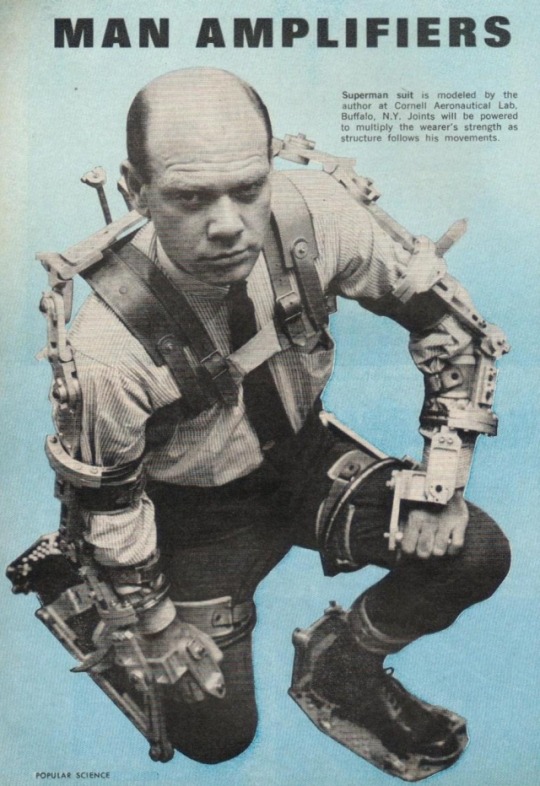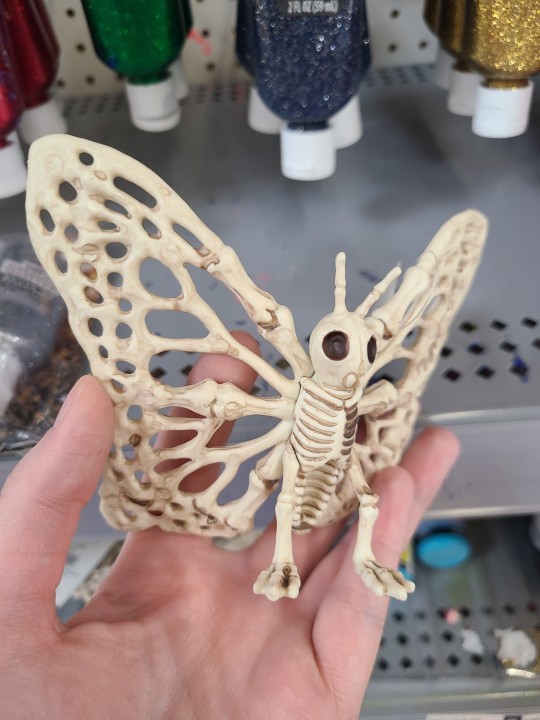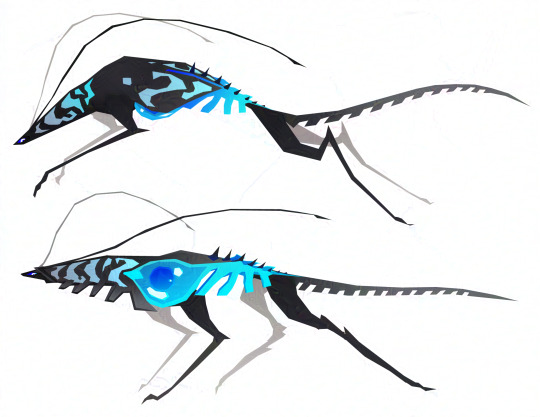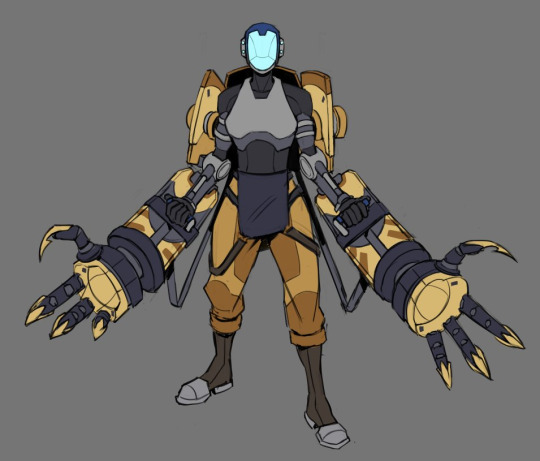#exoskeletons
Text
Descriptive words for the exoskeletons of ants:
striate - with many parallel grooves
tuberculate - with little protrusions covering the surface
reticulate - split into irregular cells
opaque - light cannot pass through
translucent - light can pass through
shiny - reflects light, has visible reflections on the surface
matte - textured to absorb and prevent visible reflections.
glabrous - smooth
punctate/foveolate - covered in little round depressions
rugulose - wrinkled
pilosity - the degree of pilosity refers to how hairy the ant is
reclinate hairs - hairs that lay flat
tomentum - wooly hairs
clavate hairs - hairs that are club-shaped
#ants#vocabulary#ant vocabulary#descriptive words#exoskeletons#myrmecology#antposting#insects#bugblr#bugs#invertebrates#antblr#entomology
440 notes
·
View notes
Text
In discussions of exoskeletons,I feel like we tend to exclude one-man-band setups. We should stop doing that
35 notes
·
View notes
Photo

Male pattern baldness is a part of being a man, so it too was amplified.
29 notes
·
View notes
Text
No no no no no
The spiders were bad enough but now this!
Bugs have exoskeletons!!!!!!
EXTERNAL SKELETONS


I just can't 😮💨
4 notes
·
View notes
Text

0 notes
Text
A biomedical engineer pivots from human movement to women’s health
New Post has been published on https://thedigitalinsider.com/a-biomedical-engineer-pivots-from-human-movement-to-womens-health/
A biomedical engineer pivots from human movement to women’s health


Watching her uncle play a video game when she was a small child started Shaniel Bowen on her path to becoming a biomedical engineer. The game, “Metal Gear Solid 2,” introduced her to exoskeletons, wearable devices that enhance physical abilities.
“The game piqued my interest when it started showing and discussing exoskeletons,” Bowen says. “I went to the library soon after to learn more about it. That was when I first learned about biomedical engineering and became interested in pursuing it as a profession.”
Fast-forward to her senior year at the University of Connecticut. Bowen and an interdisciplinary team of biomedical, electrical, and computer engineers developed a device using musculoskeletal modeling and computer-aided design that could help people with leg weakness to stand. The system provided just enough assistance that the person would still use their own muscles, strengthening them with repeated use. Bowen was on her way to creating her own exoskeleton.
That changed, however, when she was starting graduate school and was diagnosed with ovarian torsion caused by a large ovarian teratoma.
Not only was she dealing with a serious medical condition, but as a Black woman raised by Jamaican immigrants, she was personally confronted with inequities in health care that result in discrepancies in treatment.
“Like many Black, Indigenous, and people of color (BIPOC) women, I was initially apprehensive and discouraged from seeking medical care for a long time, which led me to trivialize my symptoms,” Bowen says. “A serious gynecological condition that required surgery was almost left untreated.”
After her surgery, Bowen pivoted from her work in human movement and biodynamics to biomedical engineering focused on women’s health.
“I became interested in applying my engineering expertise to women’s health issues in order to gain a better understanding of various pathologies from a biomechanics perspective and to bring awareness not only to individuals in my field but also to women who suffer from or may be at risk for these conditions,” she says.
During her doctoral program, Bowen studied the effects of age and pelvic reconstructive surgery on female pelvic anatomy and function using computational modeling. She received a Ford Foundation Fellowship from the National Academies of Sciences, Engineering, and Medicine to study the biomechanical processes involved in pelvic organ prolapse (POP), a common condition that can cause extreme discomfort, sexual dysfunction, and incontinence. POP can be surgically corrected, but the repair often fails within five years, and it is unclear exactly why. Bowen’s research set out to develop a tool to better assess the biomechanics of such failures and to prevent them.
“It is hoped that our findings, based on postoperative imaging and clinical data, will encourage longitudinal trials and studies that incorporate both clinical and engineering approaches to better understand POP surgeries and pelvic floor function and dysfunction following pelvic reconstructive procedures,” she says.
After earning her PhD at the University of Pittsburgh, Bowen received multiple offers to do postdoctoral research. She chose the MIT School of Engineering’s Postdoctoral Fellowship Program for Engineering Excellence and started work in the Edelman Lab in September 2023.
“The program and my principal investigators were the most supportive of me exploring my research interests in women’s sexual anatomy and health,” she says, “and learning experimental methods from the ground up, given that my primary experience is computational.”
Elazer Edelman, the Edward J. Poitras Professor in Medical Engineering and Science, director of MIT’s Institute for Medical Engineering and Science, professor of medicine at Harvard Medical School, and senior attending physician in the coronary care unit at Brigham and Women’s Hospital in Boston, speaks admiringly of Bowen and her research.
“I love working with and learning from Shaniel — she is an inspiration and creative spirit who is treading in new spaces and has the potential to add to what we know of health and physiology and change our practice of medicine,” says Edelman.
The Edelman Lab was “one of the few,” Bowen says she found “with a longstanding commitment to public outreach,” which has been a consistent endeavor throughout her academic career.
For nearly 10 years, Bowen has volunteered in mentoring and STEM outreach programs for students of all ages — including at her old high school, at the universities she has attended, and in underserved communities. Currently, Bowen devotes a portion of her time to outreach, health promotion, and education, primarily focusing on women’s health issues.
“My research collaborators and I have worked toward removing the stigma and misconceptions around women’s anatomy and health,” she says, explaining that helping young women from underserved communities to be more comfortable with and better informed about women’s anatomy and health is “integral to health equity and inclusion.” Such work also encourages young women to consider careers in STEM and women’s health, she says.
“It is imperative that women of diverse experiences and perspectives get involved in STEM to develop the next generation of scientists and advocates to improve the treatment of health conditions for all women.”
Part of Bowen’s postdoctoral research involves complementing her computational abilities by acquiring and improving her skills in biochemistry and cell biology, and tissue mechanics and engineering. Her current work on how clitoral anatomy relates to sexual function, especially after gynecological surgery, explores a topic that has seen little research, Bowen says, adding that her work could improve postoperative sexual function outcomes.
The MIT Postdoctoral Fellowship Program for Engineering Excellence — which, while emphasizing research, also provides resources and helps fellows to build a professional network — has provided an excellent system of support, Bowen says.
“It has really helped me learn and explore different career paths while having a great support system of fellows and staff that have provided continued motivation and life advice throughout the ups and downs of navigating through my postdoctoral training and job search,” she says.
#2023#Advice#Anatomy#awareness#biochemistry#Biological engineering#Biology#Biomechanics#career#Careers#cell#cell biology#change#Color#computer#data#Design#devices#Diversity and Inclusion#education#effects#Engineer#engineering#engineers#equity#exoskeleton#exoskeletons#experimental#Ford#Foundation
0 notes
Text

1 note
·
View note
Text
From Wearables to Implants: Exploring Augmentation Devices
Human Augmentation
Discover the transformative potential of human augmentation technology and its impact on healthcare, defense, and society. Explore ethical considerations, future trends, and FAQs on human augmentation.
Human augmentation refers to the integration of technology into the human body to enhance physical or cognitive abilities. This field represents a significant advancement in science and engineering, offering promising solutions to improve human capabilities across various domains.
Introduction to Human Augmentation
In recent years, human augmentation has emerged as a transformative field, blurring the lines between biology and technology. With rapid advancements in areas such as biotechnology, robotics, and artificial intelligence, the possibilities for enhancing human performance have expanded dramatically.
History and Evolution of Human Augmentation
The concept of enhancing human abilities is not new and has been explored throughout history, from ancient myths of superhuman strength to early prosthetic limbs. However, modern human augmentation technologies have evolved significantly, driven by scientific breakthroughs and technological innovations.
Types of Human Augmentation Technologies
Wearable Augmentation
Wearable devices such as exoskeletons, smart glasses, and augmented reality (AR) headsets are designed to enhance physical abilities or provide real-time information to the user. These technologies are widely used in industries such as healthcare, logistics, and entertainment.
Implantable Augmentation
Implantable devices, including neural implants, pacemakers, and cochlear implants, are surgically implanted into the body to monitor, regulate, or enhance biological functions. These technologies have revolutionized medical treatment and improved the quality of life for millions of people worldwide.
Applications and Benefits of Human Augmentation
Healthcare
Human augmentation technologies have revolutionized healthcare by enabling personalized treatments, improving diagnostics, and enhancing surgical procedures. From prosthetic limbs to brain-computer interfaces, these innovations have transformed the lives of individuals with disabilities and chronic conditions.
Military and Defense
In the military and defense sector, human augmentation technologies play a crucial role in enhancing soldiers' performance, resilience, and situational awareness on the battlefield. From exoskeletons for enhanced strength to advanced sensory augmentation systems, these technologies provide a competitive edge in modern warfare.
Industry and Manufacturing
In industrial and manufacturing settings, human augmentation technologies improve worker safety, productivity, and efficiency. Exoskeletons reduce the risk of musculoskeletal injuries, while augmented reality systems optimize complex assembly processes and training procedures.
Ethical Considerations and Challenges
Despite their potential benefits, human augmentation technologies raise ethical concerns related to privacy, consent, and equity. The integration of technology into the human body raises questions about data security, surveillance, and the potential for discrimination based on augmented abilities.
Future Trends in Human Augmentation
Looking ahead, the future of human augmentation holds exciting possibilities, including the integration of artificial intelligence and robotics into the human body. As technology continues to advance, the development of ethical frameworks and regulatory guidelines will be essential to ensure responsible innovation and mitigate potential risks.
Conclusion
In conclusion, human augmentation represents a paradigm shift in how we perceive and enhance human capabilities. From healthcare to defense, the applications of these technologies are vast and diverse, offering new opportunities and challenges for society. By addressing ethical concerns and embracing responsible innovation, we can harness the full potential of human augmentation to improve lives and shape the future of humanity.
FAQs
What is human augmentation?
How does wearable augmentation technology work?
What are the ethical considerations associated with human augmentation?
What role does human augmentation play in military and defense?
What are some future trends in human augmentation technology?
#Human augmentation technology#Wearable augmentation#Implantable devices#Ethical considerations#Future trends#Healthcare applications#Military and defense#Augmented reality#Exoskeletons#Neural implants
0 notes
Text

1 note
·
View note
Text
Wearable Technology in the Construction Industry: Enhancing Safety and Efficiency
Introduction
The construction industry is known for its physically demanding and high-risk nature. However, with the advancements in technology, new tools are emerging to address safety concerns and enhance efficiency. One such innovation is wearable technology, which has gained traction in recent years due to its potential to revolutionize the construction sector. This article explores the…

View On WordPress
#AR Technology#Battery Life#Collaboration Tools#construction industry#Construction Productivity#Construction Projects#Construction Safety#Cybersecurity Measures#Data Insights#data protection#Data Security#Durability#Environmental Resistance#Exoskeletons#Future Prospects#Implementation Challenges#Job Site Efficiency#On-site Support#Performance Metrics#Privacy Concerns#Productivity Boost#Real-time Communication#Remote Monitoring#Resource Optimization#Rugged Devices#Safety Compliance#Smart Glasses#Smart Helmets#Smart Vests#Wearable Costs
0 notes
Text

making my murder cannibal soup (im being hunted for sport and havent slept in six days)
#the locked tomb#harrow the ninth#harrowhark nonagesimus#i kinda didnt get how her exoskeleton is supposed to look#everyone just draws her like in gtn…..is it how its supposed to be#anyway#im still sooo artblocked its a test of character#art#my art
4K notes
·
View notes
Text
Exoskeletons || Unconventional Senses and Sensory Attributes
❯ ❯ Exoskeletons
Not traditionally thought of as a unique sense, the exoskeleton, while protecting the body, also enhances one's capacity to interpret the surrounding environment. Some animal exoskeletons specialize in providing certain types of sensory enhancements (e.g., stress or pressure sensitivity), some exoskeletons possess environment-particular chemical compositions (e.g., to maintain osmotic balance or inhibit infection).
For writers who are interested in this clever brand of defense and offense curiously bundled into the same package, one recommends researching the differences between exoskeletons, ossified scale exteriors, and for extra credit: whatever the hell turtles are made of (hint: a combination of bony plates, fused scapula, and fused rib bones, blended over countless years of evolution).
❯ ❯ Adapted from a senses-writing masterpost: 15 Unconventional Senses and Sensory Attributes
#exoskeletons#writing#writeblr#writing tips#writing advice#unconventional senses and sensory attributes#sensory details#osmotic balance#sensory enhancements#animal exoskeletons#science writing
1 note
·
View note
Text

Minewolf 🐺 🦗🧨
(Novacanis Liquidus Detonare) or Xittocoyotl
"Large insectoid canines with a sharp explosion-proof exoskeleton. They carry and produce a blue liquid in their body akin to nitroglycerine which they eject to defend and attack. Whilst solitary they can group together like a wolf pack and excel at hunting.
Thanks to their unmatched sense of smell they’re able to detect hazards early, the odor of mines and other explosives even if in different states of matter, becoming incredibly useful to demine fields after undergoing training and domestication. This species can be avoidant of humans however but once trust is gained they may become loyal companions."
#digital art#digital illustration#creature#aesthetic#art#creature design#concept art#fantasy creature#fantasy#artwork#art commissions open#demon oc#monster#speculative biology#speculative evolution#ecosystem#concept design#animal#original art#original creature#canine#wolf#insect#insects#bugs#exoskeleton#antennae#wolfdog#nature
1K notes
·
View notes
Text

IM GONNA LOAD ALL OVER THE PLACE
#risk of rain 2#risk of rain#ror2#ror#ror2 loader#my art#yeah sorry guys im a little unhinged right now#yknow that thing where the twilight creator made a genderswapped version of twilight#and everyone was like “i get it now”#thats how i feel with rorr loader#anyways#i hate drawing loader with the exoskeleton#even though i designed this one its no different to all of the other exoskeletons#one day loader will be the character ive drawn the least#for the simple reason that this exoskeleton makes me want to commit warcrimes#and not the fun ones
2K notes
·
View notes
Text
I WAS TRYING TO ASK HOW WOULD HIS EXOSKELETON UNDER HIS 'EXOSKELETON' LOOK BUT I PHRASED IT TERRIBLY AND MY PFP ISNT MAKING IT ANY BETTER

#prismos search history^#not for nefarious reasons but just cause hes curious and has no clue how bugs work/cant ask him directly cause that would be real awkward#this is terrible#im sharing this here as well because i must admit it is a bit funny#BUT I DIDNT MEAN IT LIKE THAT ! ! IM JUST AWFUL AT WORDS#my ass got lampooned over this so fast#im just trying to design him a proper exoskeleton#ALSO MY FRIEND ASKED FOR A IMAGE TO LIKE MAKE SENSE OF HIS EXOSKELETON BUT I SENT THE WRONG ONE AND IT JUST MAKES IT LOOK WORSE 4 ME#this is how i die#adventure time#fionna and cake#scarab the god auditor
1K notes
·
View notes
Text
Researchers in Antarctica to help safeguard vital krill stocks - Technology Org
New Post has been published on https://thedigitalinsider.com/researchers-in-antarctica-to-help-safeguard-vital-krill-stocks-technology-org/
Researchers in Antarctica to help safeguard vital krill stocks - Technology Org
The University of Southampton is leading an expedition to the Antarctic Peninsula to survey Antarctic krill and the baleen whales that feed upon them.
The team, who departed the UK a fortnight ago, are travelling to the remote region on a yacht to tag the whales and survey their main source of food – krill, a small shrimp-like crustacean.
A whale – illustrative photo. Image credit: Pixabay (Free Pixabay license)
Their expedition will provide data to assess whether the current fishery management framework is sufficient to safeguard krill stocks, which underpin the unique Southern Ocean ecosystem.
“The risk is that fishing becomes concentrated in krill-rich predator feeding spots and then depletes them, leaving nothing behind for the marine animals that rely on them to survive,” says Dr Ryan Reisinger from the University of Southampton, who is leading the expedition.
Antarctic krill are one of the most abundant animals on earth and are a major food source for many predators, including fish, penguins, seals and baleen whales. Antarctic krill also send carbon to the deep ocean through the sinking of their faeces and by moulting their exoskeletons. The small crustaceans are the focus of a commercial fishery and are being caught at an increasing rate to be processed into feed for fish farms (e.g. salmon) and oils for nutritional supplements.
At the same time, populations of baleen whales, a major consumer of krill, are in recovery. Fin whales – the second largest baleen whale after the blue whale, had been hunted to near extinction. Now they are growing in number, returning to historic feeding grounds, and finding themselves in competition with fishing vessels.
The Commission for the Conservation of Antarctic Marine Living Resources (CCAMLR) is the international body which sets limits on how much Antarctic krill can be caught, where and when. These catch limits are measured in thousands of tonnes across vast swathes of ocean, but krill are particularly concentrated in smaller shelf areas close to land which are frequented by both predators and fishing vessels.
To address this mismatch in scales, CCAMLR plans to implement finer scale management procedures. To inform this, the researchers from the University of Southampton, the British Antarctic Survey, the University of California Santa Cruz, and the Scottish Association for Marine Science are collecting data to better understand the distribution of foraging fin whales, Antarctic krill and fishing vessels.
Team members from the University of California Santa Cruz are fitting two different types of tags to fin whales. CATS tags provide short-term detailed data, monitoring swimming speed, direction, body orientation and more, while LIMPET tags provide longer-term information on the location and behaviour of the whales.
Dr Reisinger adds: “Tagging whales helps us to understand in far greater detail where and how whales feed on krill, information that is essential for us to manage and conserve Southern Ocean ecosystems. We know surprisingly little about how the largest whales – including fin whales – behave in Antarctica”.
The researchers are using echosounders – a type of sonar – to locate and measure swarms of krill. These are fitted to the bottom of the research vessel and a new type of autonomous vehicle called an ImpYak®. Developed by the Scottish Association for Marine Science, this is essentially a remote-controlled, impeller-driven kayak which will be used to survey near-shore areas that research vessels can’t reach.
Three University of Southampton PhD students are on the expedition, funded by the INSPIRE programme. Amy Feakes, one of the PhD students, said: “Being part of this research cruise has been an incredible learning experience – from collecting data for my PhD to understanding the planning that goes into a research cruise. Working in this challenging environment and with new equipment and technology has given me some new skills which I can hopefully continue to use throughout my PhD.”
The data collected from this fieldwork will be combined with information on fishing vessel activity provided by CCAMLR and Global Fishing Watch to model overlap between krill, whales and fisheries, to provide forecasts which could be used for finer scale, more dynamic fisheries management.
Dr Sophie Fielding, an ecologist at the British Antarctic Survey, said: “Antarctic krill play a central role in the Antarctic marine ecosystem. Making measurements of krill (prey) alongside their predators (whales) in near-shore areas is technically challenging and will provide new insights into controls on swarm behaviour and distribution.”
The project is funded by the UK Government through Darwin Plus.
Source: University of Southampton
You can offer your link to a page which is relevant to the topic of this post.
#Animals#Antarctic#Antarctic krill#Antarctic Peninsula#Antarctica#baleen whales#Blue#carbon#cats#Classical physics news#competition#Conservation#crustaceans#data#deep ocean#direction#earth#Ecosystems#Environment#equipment#exoskeletons#extinction#fish#fisheries#fishing#focus#Food#framework#Global#Government
0 notes